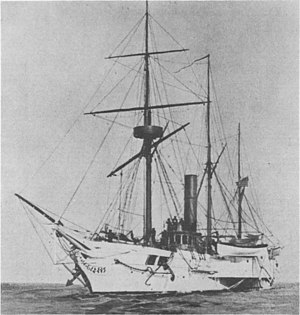USS Michigan (1843)

USS Michigan, seen here after her name was changed to USS Wolverine in 1905.
|
|
| History | |
|---|---|
|
|
|
| Name: | Michigan |
| Ordered: | 19 May 1842 |
| Builder: | Stackhouse and Tomlinson |
| Laid down: | 1842 |
| Launched: | 5 December 1843 |
| Commissioned: | 29 September 1844 |
| Decommissioned: | 6 May 1912 |
| Renamed: | Wolverine on 17 June 1905 |
| Struck: | 6 May 1912 |
| Fate: | Scrapped in 1949 |
| General characteristics | |
| Displacement: | 685 tons |
| Length: | 163 ft (50 m) |
| Beam: | 27 ft (8.2 m) |
| Draft: | 9 ft (2.7 m) |
| Propulsion: | 2 × 330 ihp (250 kW) steam engines |
| Speed: | 10.5 kn (12.1 mph; 19.4 km/h) |
| Capacity: | 115 tons of coal |
| Complement: | 88 officers and men |
| Armament: |
|
| Notes: | |
USS Michigan was the United States Navy's first iron-hulled warship and served during the American Civil War. She was renamed USS Wolverine in 1905.
The side wheel steamer Michigan was built in response to the British Government arming two steamers in response to the Canadian rebellions in the late 1830s with Secretary of the Navy Abel P. Upshur selecting an iron hull partly as a test of practicability of using such a "cheap and indestructible a material" for ships. The ship was designed by Samuel Hart, and fabricated in parts at Pittsburgh in the last half of 1842, transported overland and assembled at Erie. The launch on 5 December 1843 was unsuccessful with the ship sticking after moving some 50 feet (15.2 m) down the ways and efforts to complete the launch ended by nightfall. On returning in the morning Hart found Michigan had launched "herself in the night" and was floating offshore in Lake Erie.
By 1908 the ship was noted in the journal The American Marine Engineer as being the oldest metal hulled vessel then existing and of interest to engineers because of the ship's age. The two engines were inclined simple steam engines of 36 inches (91.4 cm) with a 96 inches (243.8 cm) stroke that were original and running well in 1908. The first of three sets of boilers were return flue type that lasted fifty years before finally being replaced by bricked in return tube types. The operating pressure was low, 25 pounds (11.3 kg) sufficient to drive the engines at 20 rpm, with engine room piping of .125 inches (0.318 cm) thick copper connecting with brass flange joints. When, about 1905, the ship finally changed from kerosene lights to electric a special engine for the dynamo had to be constructed to operate on the low pressure steam. The steam was also used in a peculiar system for repelling boarders with hot water direct from the boiler. Coal consumption before the latest modifications was two tons per hour and after the modifications was as low as one half ton per hour. The ship carried two steam launches. The ship had never made even ten knots until dispatched from the harbor at Cleveland to Buffalo to prevent riots on the assassination of President William McKinley 6 September 1901 and, with the safeties weighted, she made almost fourteen knots at 30 rpm at one point.
Michigan commissioned 29 September 1844 under the command of Commander William Inman and operated on the Great Lakes out of Erie, Pennsylvania, throughout her career. In May 1851, she assisted in the arrest of Mr. James Jesse Strang, known as "King James I", who headed a dissident Mormon colony on Beaver Island at the head of Lake Michigan, some 37 mi (60 km) from the Straits of Mackinac. Strang was soon freed, but was assassinated by two of his followers on 19 June 1856. The assassins fled to Michigan for sanctuary and were taken to Mackinac and released.
...
Wikipedia
